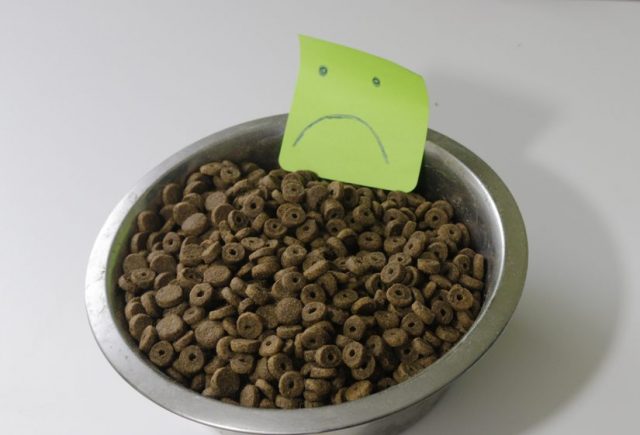Nutrition and ingredient labels can be confusing enough on “human foods,” but trying to read them on your dog’s kibble bag — marketing ploys included — it can be downright cryptic! What’s more, certain terminology can be very misleading, with words defined by the Association of American Feed Control Officials (AAFCO) that may not mean exactly what you think. This is incredibly frustrating for pet parents who only want to give pooches the healthiest food they can find for their budget.
If trying to decode your pup’s chow makes your eyes glaze over, read on. Below, check out 7 things every pet parent should know about dog food labels.

1. First ingredients aren’t always what they seem
The first item on an ingredient panel is most prevalent in the product, right? Well, kind of.
While technically the ingredients are listed in order of weight, pet food companies have tricks meant to mislead consumers. For instance, the ingredients are ranked before they’re processed, and meat loses around 70% of its mass once it’s dehydrated. What’s more, companies can break down filler ingredients (like starches and grains) into multiple parts so that their percentages are lower than the protein component. An article by Digest explains:
For example, a product label containing 20% meat and 80% starches could either look like:
Rice (30%), peas (30%), Beef (20%), potatoes (20%)
or:
Beef (10%), beef heart (10%), long grain rice (10%), brown rice (10%), white rice (10%), split peas (10%), pea protein (10%), english peas (10%), potato (10%), potato starch (10%).
Pretty sneaky, huh?
Related: 7 Best Dehydrated Dog Foods
2. How AAFCO defines “with”
If you get your pup a variety a food that contains the word “with” on the label — such as, “with chicken” — that little preposition only has to represent 3% meat, according to Netflix documentary Pet Fooled. Therefore, your pooch’s food made “with chicken” may only contain 3% poultry… and 97% mystery.
3. How AFFCO defines “dinner,” “nuggets,” “formula” & “flavor”
Just so you know, your dog’s beef “dinner,” “nuggets,” or “formula” only have to contain 25% meat. And the label “flavor” is the worst – “flavored” foods don’t have to contain any real meat at all, explains Pet Fooled.
4. The origins of meat meals and by-products
Meat by-products and meals are commonly found in pet foods. They’re the result of what’s leftover when animal carcasses – feathers, hooves, teeth, and all – are boiled down and processed into a powder. But the most disturbing part is where the corpses could have come from: leftovers from slaughtered farm animals, road kill, diseased animals, and euthanized animals are all examples of what’s being rendered.
When looking at the ingredients in your pooch’s food, look for specific and whole protein sources like beef, poultry, lamb, or salmon. On the flip side, here are some questionable ingredients to avoid, according to Dog Food Advisor.
- Meat meals
- Animal meals
- Meat and bone meals
- Chicken (or beef, or poultry, etc.) by-product meals
- Chicken (or beef, or poultry, etc.) meals
- Blood meal
5. What is meant by “cage-Free” chickens & eggs
Egg labels are very confusing when it comes to both human and animal foods. While the term “cage-free” may evoke visions of free-roaming chickens across acres of farmland (and pictures on packaging may encourage this notion) don’t be fooled. Chickens not in cages can still be crammed in small spaces like barns. Even “free range” chickens may not be living all that “free,” according to The Balance Small Business. Legally, they need to have access to the outdoors, whether it’s at their leisure or just for a few minutes a day before getting herded back into a dirty pen.
If you want your pup eating chicken and egg products that were humanely raised, Open Farm says to look for these seals: Certified Humane (By Humane Farm Animal Care), Global Animal Partnership, and Animal Welfare Approved.
6. The definitions of feed grade and human grade.
Would you feed your family members feed-grade food? Well you don’t want to give your dog ingredients of questionable quality either! According to Truth About Pet Food:
“The difference between human grade pet food and feed grade pet food can be dramatic or no difference at all.
The legal definition of feed grade pet food is: ‘Material that has been determined to be safe, functional and suitable for its intended use in animal food, is handled and labeled appropriately, and conforms to the Federal Food, Drug and Cosmetic Act unless otherwise expressly permitted by the appropriate state or federal agency.’
This definition means just about anything is allowed into feed grade pet food.”
If any of the ingredients in your pup’s food are “feed grade,” it’s best to err on the side of caution and steer clear. On the flip side, human grade pet foods in their entirety — from ingredients to processing to packaging — could be safely consumed by people. Obviously, this is usually going to be your safest choice!
Related: 11 Best Limited Ingredient Dog Foods
7. Unnecessary ingredients that you should never see in your dog’s food
It’s bad enough that some pet food companies use ingredients that are sub-par, but it’s ridiculous for them to use ingredients that are not only useless, they’re unhealthy. Certain brands even color kibbles in order to appeal to the dog’s humans; remember, dog’s don’t see color like we do!
Some ingredients that you should never see in your pet’s food include: corn syrup (for flavor), dyes (to appeal to owners), propylene glycol (a preservative and sweetener), ethoxyquin (another preservative, which is also used in pesticides), whole grain corn (a cheap filler with no nutritional value), and beef tallow (fat used for flavor in the absence of actual beef).
Long, hard-to-pronounce words should always raise a red flag, and while not all of them are bad, a quick Google search will tell you whether or not it’s safe enough to feed your beloved dog.
If you want an in-depth look at your pup’s food, Dog Food Advisor is a wonderful resource that rates and breaks down the ingredients on thousands of different pet foods.


 Toledo, United States.
Toledo, United States.
